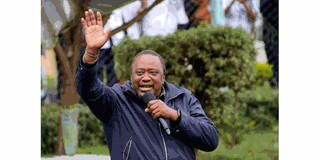Govt can borrow a leaf from Uhuru Kenyatta

President Uhuru Kenyatta addresses wananchi at Othaya town in Nyeri county moments after he commissioned Mwai Kibaki Hospital on August 6, 2022. PHOTO/NMG
What you need to know:
The issue: Uhuru Kenyatta’s presidency
Our view: All indications suggest that Mr Uhuru has been alive to the possibilities that sprout from treating rail and water transport as a public good
As East Africa prepares to talk about Mr Uhuru Kenyatta’s presidency of Kenya in the past tense, the settled notion that he leaves a rich legacy of infrastructure development is difficult to fault. The nearly 11,000km of tarmacked roads built under his stewardship offer unstinting support.
Yet as the 34th meeting of the Northern Corridor Council of Ministers noted early last month, there is still work to be done.
The development and use of the Standard Gauge Railway (SGR) particularly came in for a drubbing. This was underscored by the fact that Kenya’s SGR sputtered to a halt near Naivasha. While a paucity of funds stalled progress, Uganda’s bureaucratic foot-dragging has threatened lasting and damaging consequences. The delayed commitment to construct the SGR to Malaba means that our railways face a future of managed decline.
An even more troubling dimension is the fact that this is not the only Northern Corridor integration project threatened by tenuous Ugandan interest.
The completion of the oil jetty on the Ugandan side of Lake Victoria is still outstanding. Elsewhere, the Kisumu oil jetty—in Kenya—was completed in 2018.
Lake Victoria, which is supposed to be a key transit point for oil, continues to face strong headwinds thanks to delays from the Ugandan side.
Under Uhuru, Kenya managed to upgrade its Kisumu port to handle a capacity of 50,000 twenty-foot equivalent units. Our eastern neighbour has also retouched the MV Uhuru, a train wagon ferry with a carrying capacity of 1,800 tonnes. Nearly a week ago, the floatation of the MV Uhuru II was overseen. The 100-metre vessel—made in Kenya by Kenyans—can carry up to 22 wagons, with an estimated capacity of two million litres of crude oil per trip.
All indications suggest that Mr Uhuru has been alive to the possibilities that sprout from treating rail and water transport as a public good. His presidency appreciated that investment and imagination are needed during a crucial decade when a transition away from cars, not trains, is the priority.
Meanwhile, President Museveni’s plans continue to create more red tape than the Kenyatta-esque revolutionary policy that is needed. “The NRM answer to this imported inflation and fuel prices is to shift from petroleum cars to electric vehicles and motorcycles and then the train. We are going to spend the money we have on those,” Mr Museveni revealed last week in his umpteenth national address.
Barely hours after that address, Mr Fred Byamukama—the junior Works and Transport minister—revealed that Shs1.144trillion has been earmarked to revamp 1,266km of already existing railway lines by early 2025. The Kampala-Malaba line that has stalled the SGR was mentioned, with a November 2022 completion date promised. Other routes that were mentioned include: Tororo-Gulu, Gulu-Pakwach and Mukono-Namanve-Kyengera.
Fifteen new locomotives and 300 wagons were also held out as promises. The decision not to be driven by a short-sighted determination is, we believe, noteworthy. Our government, however, ought to be candid about past mistakes that prompted a grim report from the Northern Corridor Council of Ministers last month. There should be no bureaucratic foot-dragging this time around.
Our commitment to you
We pledge:
- To be accurate and fair in all we do.
- To be respectful to all in our pursuit of the truth.
- To refuse to accept any compensation beyond that provided by Monitor Publications Ltd. for what we do in our news gathering and decision-making.
Further, we ask that we be informed whenever you feel that we have fallen short in our attempt to keep these commitments.




